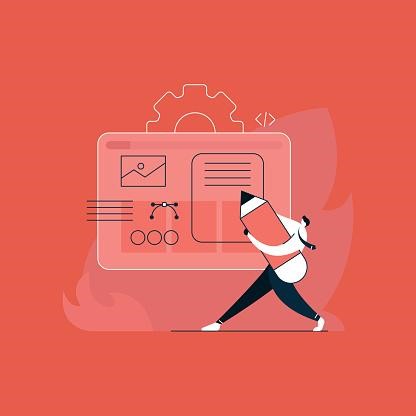Consumers expect to respond quickly, receive more information, hear clearer voices, and see brighter images. Our company provides companies with top tech talent and product-development expertise that will help them build high-quality software. Let’s discuss how we can assist you.
Scalable apps provide a stable workflow 24 hours a day – they are less likely to experience crashes during seasonal events like Cyber Monday. These events project an increase in in-app traffic and data usage.
It allows for adjustments to the local laws of different countries. Some countries do not allow personal data to be stored outside their borders. This aspect is where servers’ distribution can help adhere to such laws.
It ensures that connection speeds are maintained in various parts of the globe – scaling apps can be identified by the geographical distribution of servers around the globe. Servers in different countries can provide sufficient response times for peak speeds.

What does a large-scale web app mean?
According to O’Reilly-Scalability is a key factor in the ability of your web application to meet these expectations and allow it to grow over time.
This article will explain Scalability and provide solutions to the challenges and steps involved in large-scale web app development. Let’s begin with the basics.
Scalability refers to the ability of an app to maintain consistent performance regardless of how many people are using it simultaneously.
A large-scale web application can handle huge amounts of traffic and data and adapt to extreme load changes without affecting its quality.
It can be analyzed on:
Performance: High-traffic applications can process a thousand transactions per minute or millions of requests/users as efficiently as one hundred.
Distribution: It uses servers that are closer to the users.
Data: It can handle large amounts of various data types (e.g., tracking customers’ behavior and handling them).
Accessibility: It can be accessed at any hour of the day or week.
What is the importance of Scalability?

Scalability is crucial if you want to create a complex (e.g., a loyalty app) that can simultaneously support multiple users.
It meets market needs – as market expectations constantly change, a scalable application will be more likely to meet customers’ needs. Your marketing efforts will increase user traffic and transaction volume, which will help you maintain a positive user experience.
Scalability allows the system to handle higher loads – it can adapt to changes in your business, such as an explosive increase in customers or data volume. Strategic scalability testing helps prevent bugs or glitches and improves growth potential, ROI, and user feedback.
It is more profitable financially – an app that scales up to a million users from the beginning can be remade when it drops from 10K to 100K or up to 9000K.
Your web application should run 24 hours daily under different traffic and workload conditions. This factor will positively impact customer experience and, ultimately, your profit. Is this possible in all situations?
Is your business in need of a large-scale enterprise app?
Let’s look at an example to answer this question.
Social media influencers often face the same problems when exciting a product launch on their channels. The followers have been directed to a website, and the product is not selling in the promised time. Instead of teasing a restock date, they had to film an apology video for their customers.
This wouldn’t happen if their web app could handle the increased load. Customers could buy as many items in stock as they have at once with a scalable app without worrying about it crashing.
You don’t have to be the most popular product in the world. You may see it grow in popularity slowly. Your web app must be highly-performing if your business is to succeed.
Your app may not be needed if there aren’t any compelling reasons to believe it will grow. This factor is the case with newly launched startups. Right?
These sections will help you determine if your app requires it.
Benefits of large-scale app development
How to create scalable applications: Considerations, steps, and design
You might think that every application should be saleable from the beginning. There is no guarantee that a project will succeed when it starts. You should follow lean software development principles. Your main goal is to get a product to market and test how it performs. Scalability is probably not necessary at this stage.
If you are sure your product will succeed in the marketplace and grow, scaling the backend and front end is a good idea. These stages will help you create scalable apps from existing web products.
7 steps to design large-scale enterprise apps
Let’s get right into it:
- Identify your scaling needs.
- Choose the best monitoring tools, infrastructure patterns, databases, and frameworks.
- Determine the appropriate monitoring tools, infrastructure, database, pattern, and framework.

1. Assess the need to scale and manage expectations
Scaling an app that is already in use can be expensive. However, scaling can be costly if you add features or make existing ones more complicated. Your current functionality may not be able to handle these changes.
Be sure to justify the costs of scaling. Scalability is not something that everyone else is talking about.
How can you tell if you are required to create a large-scale website? These are some questions that will help you make a decision.
Are you expecting an increase in users? How much and for how long do you expect to see an increase in users?
How long will your customer/user base be able to use the server(s) currently in use?
Which storage plan do you use? Are you able to change the size of your storage plan?
What are your options if you notice a dramatic increase in data and user traffic?
2. Use metrics to identify your scalability problems
After careful consideration, your application is decided to scale. Next, you will need to determine which scalability issues are most important. You can track the following metrics to do this:
Use of CPU. This aspect is an essential metric that most app-monitoring software can measure. Your app has high CPU usage and could be experiencing performance problems.
Memory usage. This aspect is calculated for each process in your app and then combined into one execution.
Network Input/Output. This refers to the period it takes to send data from one process to another. It will help if you look for the instances that take up the most time.
Disk Input/Output. These are all operations that occur on a physical drive. It’s also time-consuming: while your app reads data from a file, the CPU is still on standby.
3. You can use tools to evaluate metrics and monitor Scalability
App-monitoring tools are needed to monitor related metrics and identify problematic areas. AppDynamics and Stackify Retrace are some examples.
After choosing a tracking tool, run tests for the metrics mentioned above. If you get high results from any of these metrics, it is important to investigate the issue and develop test cases to scale your app.
These are your baselines. Keep track of the metrics you use to develop large-scale apps.
You can use PaaS, such as Amazon Web Service, Heroku, or IBM Cloud, to monitor your usage. This is a reminder:
4. Select the best infrastructure options to ensure Scalability
Cloud services are recommended for web apps. They take care of many aspects related to web app development and maintenance. These include infrastructure and storage, servers and networking, and middleware and runtime environments.
PaaS makes scaling simpler because they provide auto-scaling and reliability and the availability of SLAs.
AWS, Heroku, or IBM Cloud are options if you don’t have a PaaS.
5. Select an architecture pattern that suits your app’s Scalability
It is important to choose the right architectural pattern. Some features will be critical for scaling your app, while others may be only necessary for certain users at specific times.
6. Scale the database that is right for you
The data type you require to store the data will determine which database you choose. First, you’ll need a relational database such as MySQL or PostgreSQL. For the second, you’ll need a NoSQL data source, such as MongoDB.
It should be simple to integrate any database into your app.
7. Select a scalable framework for your application
Application frameworks allow for web-based development and graphical user interfaces. They allow for code sharing between different modules and reduce development issues.
These are the top four most popular architectural patterns:
1. Layered architecture
This name is easy to remember, as layers are used in apps built with this architecture. Each layer has a task, and data must travel from top to bottom through each one.
This type of form is best suited for:
- New apps that are only available for a short time
- Apps that must be maintained and tested to strict standards
- Developer teams, who don’t have a deep understanding of architectures or much experience developing them, are at risk.
- Enterprises that follow traditional IT department processes.
- Our company provides companies with top tech talent and product-development expertise that will help them build high-quality software. Let’s discuss how we can assist you.
2. Event-driven architecture
Unlike the layered architecture, this type has a central unit and modules that interact with data specific to them. When an event occurred, the central unit delegated the data to the module designated to that data type.
The best type of architecture for events is:
- Development of asynchronous systems
- User interfaces.
3. Microkernel architecture
This type includes a core system and plug-in modules that offer additional functionality and specialized processing to improve the core functionality. WordPress is a simple example of such architecture.
This type of form is best suited for:
- Apps that appeal to a broad audience are more successful.
- There are instances when you can tell the difference between basic and more important needs.
- There are instances when you can tell the difference between dynamic and core routines.
4. Microservices architecture
This high-performance web architecture allows you to build flexible applications. It is a distributed system that connects to individual web services via lightweight protocols.
You can create, test, deploy, and monitor individual services using the microservices approach without affecting the entire app.
The best microservices architecture is:
- When different tasks can be done separately and don’t impact each other.
- Websites with very small components
- For rapidly growing applications,
- When hiring software developers that are distributed in different countries.
Checklist: How to design a large-scale app
Your ability to choose the right infrastructure and architecture patterns to support your web app’s growth will determine its success.
Four things to consider when creating a scalable web application
We recommend you consider and implement a few other aspects of large-scale design besides the tools and patterns.
Architecture. Patterns were already discussed, but high-traffic web apps also require techniques to ensure that applications are built. Although patterns are the design aspect of web application development, selecting the right programming language, framework, and APIs for your application is important.
TDD (Test Driven Development) is a method of developing applications where your requirements are converted into test cases. This approach is useful for scalable development as you already have test cases.
CI (Continuous Integration). Continuous integration is a DevOps technique that allows continuous integration of code changes. This is most useful for projects requiring timely results and multiple contributors.
Security. While no web app is 100% secure, some practices can improve security against hackers.
The passwords are kept in salting and hashing databases to access only those with the passwords.
Secure client-server communication using a JSON Web Token (JWT).
Set expiry for session cookies that contain JWT.
Once you have chosen the right tools and technology and set up the processes, it is time to design your large-scale app.
How to design saleable web app architecture
- Another thing to consider when designing scalable web apps architecture is whether you are scaling up or down.
- Vertical scaling is also known as up-scaling. It refers to adding more resources and memory to existing systems.
- Horizontal scaling is also known as out-scaling. It refers to creating a distributed architecture. For example, adding more nodes can increase the app’s capacity.
- Horizontal scaling is better for most purposes because it is simpler to implement, more affordable, and results better. This is especially true considering the increasing popularity of cloud databases in web application development.
- These 200 startups & tech companies are outsourcing to India because they believe it is the best place.
Design components of web app architecture
A few components allow large-scale application design to be possible:
Cloud storage. Cloud storage is convenient because you can adjust the storage capacity based on your application’s stage. This permits you to pay only for what you use. There are both NoSQL and relational cloud databases.
Distributed cache structure. Nodes are needed to store cache data to make it more accessible when it is needed again.
Microservices. These are components that are not connected but can be scaled separately.
When Scalability is needed, why is microservice architecture the best option?
This guide has a lot of microservices in web application architecture. Microservices architecture is better in terms of scale. It guarantees:
Fault isolation. Fault isolation. Because the system isn’t a single entity and microservices can be used individually, failures will not affect the whole app but only one component.
There are no ties to a single tech stack. You can also use different technology stacks if you need them. Another benefit of loosely connected components is:
Simpler. When you hire remote developers, microservices architecture will allow for a better understanding of the service functionality.
Rapid deployment. Because of the smaller area, you can deploy changes more quickly.
Microservice Architecture has Major Advantages.
What are the challenges in building scalable systems?
It would help to consider the following challenges when planning to build an app or scale an existing one.
- In-house costs. You might find it difficult to afford the systems required to manage large-scale apps.
- Time expenses. It can take time to control the cost and research exactly what your app needs.
- Bad experience or hardware. Installing new servers or acquiring knowledge in data center management could also be problematic.
How can we solve these problems?
- Hiring an expert in scaling web applications or high-performance web design is better than trying to do everything yourself. This aspect will allow you to achieve your business goals in the most efficient way possible. The relevant software is the right choice.
- Talented professionals – 85 percent of our tech team are Senior and Middle Engineers.
- We have more than 200 small projects that we have completed in our eight years of experience.
Global recognition: Our clients worldwide, including the USA, Norway, Germany the UK.
Please send us your inquiry to learn more about how we can help you develop your new, scalable web app.
Need help with software development?
Relevant offers full-cycle product development services, including market research, business analysis, design, development, launch, and maintenance. We can assist you in creating your product from A-Z. Get a quote by contacting us.
Get a free quote
To make a winning investment, consider the following: Enterprise Mobility, Enterprise Application Development, Developers Of Enterprise Apps, Enterprise App Developers, Enterprise Application Design, and Enterprise Applications Development Process.
Consider Enterprise Solutions, Enterprise Tools, Examples Of Enterprise Software, Business Articles, Expertise With Business Owners, and Exceptional User Experience.
Experience To Mobile is great.
Enable Customer Relationship Management, Employee Apps with a House Team, and Key Features.
This blog answers Key Questions and an Excellent Idea to make a Mobile Investment.
Conclusion
For web applications that can scale to meet changing market needs, Scalability is crucial. Your applications must be scalable if you want to grow your business. You can still evaluate your existing enterprise apps for Scalability and then improve them according to the problems you discover. A dedicated team at Squash Apps helps you achieve your project goals.
FAQs
Are large-scale enterprise applications the best choice?
Building such apps presents some challenges. Many costs are involved in scaling an enterprise app development, such as hardware and software. This requires expertise that your team may not have.
How to overcome challenges in large-scale enterprise applications?
These challenges can be overcome by hiring a team with extensive experience in custom website development – Relevant software. You will find:
Full-stack web application development: We take care of front-end and backend web design and create single-page apps.
Proper technologies: We use technologies that guarantee web applications’ reliability and security, such as React and Angular, PHP, and Python.

Dr.Supreena has published two international books in finance with the able guidance of her guide and department at Ethiraj College of Women, University of Madras during her PhD in Economics and Finance. She is the Recipient of Dr Vedagiri Shanmugasundaram (An Oxford Scholar) Award for Outstanding and Successful PhD Candidate from Ethiraj College for Women concerning research record and academic distinction. She is experienced in the domain of finance, digital marketing and information technology writing on Artificial Intelligence, IoT, PaaS and SaaS cloud computing etc. She is NIIT qualified in Advanced Network Computing, Google Certified in digital marketing. Her hobbies to maintain balance and reduce stress are gardening and cooking.


